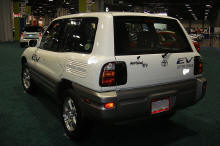 |
|
Manufacturer |
Toyota |
| Production |
1997-2003 |
| Assembly |
Tahara, Aichi, Japan
Toyota City, Japan |
|
Class |
Mini SUV |
|
Body style(s) |
4-door
SUV |
|
Layout |
FF layout |
|
Transmission(s) |
1-speed
automatic |
|
Wheelbase |
94.9 in (2410 mm) |
| Length |
156.7 in (3980 mm) |
| Width |
66.7 in (1694 mm) |
| Height |
64.4 in (1636 mm) |
The first fleet version of the RAV4 EV became available on a limited
basis in 1997. In 2001 it was possible for businesses, cities or
utilities to lease one or two of these cars. Toyota then actually sold
or leased 328 RAV4 EVs to the general public in 2003, at which time the
program was terminated despite waiting lists of prospective customers.
The RAV4 EV closely resembles the regular
internal combustion engine (ICE) version - without a tailpipe - and
has a governed top speed of 78
mph (~126
km/h) with a range of 100 to 120 miles (160 to 190 km). The 95
amp-hour
NiMH battery pack has a capacity of 27
kWh, charges
inductively and has proven to be surprisingly durable. Some RAV4 EVs
have achieved over 150,000 miles (240,000 km) on the original battery
pack. It was also one of the few vehicles with a single speed
automatic transmission at that time.Toyota tested the RAV4 EV in Japan
for 300,000 miles (480,000 km) over two years before introducing the
vehicle in the United States.
Besides the batteries, controller and motor, the remaining systems in
the RAV4 EV are comparable to the gas-powered RAV4, such as power
brakes,
power steering,
air conditioning, tire wear and suspension components except for the
power sources involved. The power brakes use an electric pump to provide
vacuum instead of deriving vacuum from the engine manifold while the
power steering and air conditioning systems use electric motors instead
of mechanical energy delivered by fan belts. The passenger compartment
heater is electrical.
Performance
The RAV4 EV has a governed top speed of 78 miles per hour (126 km/h),
a tested 0-60 time of around 18 seconds (depending on state-of-charge on
the batteries) and a range of 80 to 120 miles (130 to 190 km). Mileage
depends on the same factors as a traditional gasoline-powered vehicle,
mainly
rolling resistance and average speed (aerodynamic
drag).
Charging
The RAV4 EV has 24 12-volt 95Ah NiMH batteries capable of storing
27.4 kWh of energy. The RAV4 EV's batteries can be recharged from being fully depleted to
fully charged in about 5 hours, and are monitored with a passive battery
balancing system. Charging is supplied via magnetic induction by a
wall-mounted 6000-Watt charging unit on a 220 volt, 30 amp, North
American "clothes dryer"-type plug.
In addition, the RAV4 EV has a charge timer built into the dashboard
that enables the vehicle to start charging at a specific time. As the
RAV4 EV easily becomes the main cost of electricity in an average-sized
home, this enables the owner to use a
Time-Of-Day Meter to reduce electricity costs. This configuration is
a standard practice with RAV4 EV owners. The price of electricity at
night depends on the carrier, but is usually in the range of 60% of the
normal rate. In the use of charging the RAV4 EV, this equates to a
cheaper cost-per-mile, roughly equivalent to a vehicle capable of
166.6 mpg-US (1.412 L/100 km; 200.1 mpg-imp),
based on a price of USD 3.00 per gallon.
The United States Environmental Protection Agency listed mileage
ratings for the RAV4 EV in its yearly Fuel Economy Guide from 2000
through 2003. The
2003 model recorded city mileage equivalent to 125 mpg-US
(1.88 L/100 km; 150 mpg-imp), and 100 mpg-US
(2.4 L/100 km; 120 mpg-imp) on the highway.
Estimated combined mileage was 112 mpg-US
(2.10 L/100 km; 135 mpg-imp).
Public availability
RAV4 EVs were only available for three-year fleet lease, not for sale
and not for lease to the public, at a few dealerships beginning in 1997.
In 2001, leases were made available to small "fleets of one" purportedly
run by small businesses.
 Rear view of one of the 328 RAV4 EVs sold to the public.
Rear view of one of the 328 RAV4 EVs sold to the public.
In March 2002, due to a shift in corporate policy, the Toyota RAV4-EV
was made available for sale to the general public, but only 328 of them
sold. No one knows for certain what prompted Toyota to change their
position on the RAV4-EV, since they had long since fulfilled their
obligations under the MOA with the California Air Resources Board's
zero-emissions vehicle (ZEV) mandate via its fleet lease program.
The
MSRP was USD 42,000; but in California, ZIP-grant rebates of USD
9,000, decreasing in 2003 to USD 5,000, and a USD 4,000 credit from the
Internal Revenue Service brought the price down to a more palatable USD
29,000 (USD 33,000 for some 2003 deliveries), including the home
charger.
By November 2002, the 328 RAV4-EV’s Toyota had committed to were
sold, yet demand was continuing to build. Toyota was caught off-guard by
the extent of the demand because the vehicle's retail buyers had outsold
the projections far faster than the vehicles could be supplied to market
- despite very little advertising, and very little public awareness of
the product.
There was certainly a market for these vehicles, because many
GM EV1,
Ford Ranger EV and
Honda EV Plus drivers had been reluctantly forced to surrender their
cars – in some cases to the crusher – and had become disillusioned with
the carmakers. Potential buyers were encouraged by the perception that
Toyota was finally playing fair.
As it turned out, there were more RAV4-EVs sold than there were cars
available. It is noteworthy that Toyota did, in fact, play fair and
filled every last order despite the fact that the last few dozen
vehicles had to be painstakingly assembled from spare parts due to a
shortfall of production components. This unexpected development caused
deliveries to trickle on into September 2003. It also caused variations
in the vehicles such as heated seats, retractable antennae, mats, etc.
Once the last of the 328 EVs was sold in November 2002, the website
disappeared and the EV program was unceremoniously scrapped. No
additional cars could be bought because Toyota didn’t have anything to
sell. The RAV4-EV was based on the 1996-2000 gasoline powered RAV4,
which had become obsolete. Production of additional vehicles would only
be possible under one of two different scenarios. The first would be if
the RAV4-EV was redesigned to fit the 2003 RAV4, and the second would be
if production of the 1996 version was resumed. Toyota claimed that tens
of thousands of orders would have been necessary for them to resume or
continue production, and development time would have been a major
obstacle.
Whether or not Toyota wanted to continue production, it was unlikely
to be able to do so because the EV-95 battery was no longer available.
Chevron had inherited control of the worldwide patent rights for the
NiMH EV-95 battery when it merged with Texaco, which had purchased them
from General Motors. Chevron's unit won a USD 30,000,000 settlement from
Toyota and Panasonic, and the production line for the large NiMH
batteries was closed down and dismantled. This case was settled in the
ICC
International Court of Arbitration, and not publicised due to a
gag
order placed on all parties involved.
Only
smaller NiMH batteries, incapable of powering an electric vehicle or
plugging in, are currently allowed by Chevron-Texaco.
So for those seven months in 2002 a full-sized production electric
car was available for sale to the general public for the first time in
decades. Buying one wasn't easy, however; just one special sales person
at only a dozen dealers - and only in California - was authorized to
sell the Toyota RAV4-EV. If an individual wasn't already aware of the
car, they were generally unable to buy (or even see) one. Many would-be
purchasers were steered instead to Toyota's
Prius
gasoline electric hybrid vehicle, despite having asked about the
plug-in car.
Discontinuance

Toyota RAV4 EV leased to the public, circa 2001.
Toyota discontinued the RAV4 EV program one day after the passing of
new air-quality requirements by the
California Air Resources Board (CARB). CARB eliminated most of the
Zero Emissions Vehicle (ZEV) requirement, substituting a greater
number of
Partial Zero-Emissions Vehicles (PZEVs) to meet the requirement. A
Super Ultra Low Emission Vehicle (SULEV) category was also added.
This program requirement was designed to obtain equivalent emissions
reductions by substituting less expensive, more general purpose
vehicles.
Continuing support
Like other manufacturers, Toyota began destroying RAV4 EVs as they
came off lease, after lease continuances were denied to owners. In 2005
an agreement was struck between Toyota and
DontCrush.com (now
PlugInAmerica.com) to stop the destruction and facilitate the
continued operation of owned and leased vehicles. While no longer sold,
the vehicle is still supported by selected Toyota service centers
(mainly in California) and a strong owner community.
Sales
RAV4 EV Production by Year (est.)
| 1997 |
69 (fleet lease only) |
| 1998 |
359 (fleet lease only) |
| 1999 |
255 (fleet lease only) |
| 2000 |
106 (fleet lease only) |
| 2001 |
160 (fleet lease only) |
| 2002 - 1st half |
218 (fleet lease) plus 147 (sold/lease-purchase) |
| 2002 - 2nd half |
82* (fleet lease) plus 153 (sold/lease-purchase) |
| 2003 - 1st half |
28 (sold/lease-purchase) |
| Total |
1575* |
* Indicates estimate, based on serial numbers 1001 through 2575



